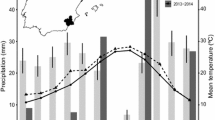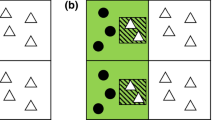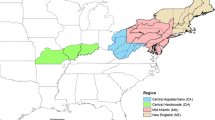Abstract
Almost all climate change studies of plants and animals adopt an ‘equilibrium assumption’ that analyses of natural distributions provide reliable estimates of species climatic requirements. Yet commercial forestry trials around the world have shown that many tree species can grow successfully under climatic conditions somewhat different from those of their natural distributions. Under climate change it is reasonable to assume that a long-lived tree species, already well-established at particular sites, may be able to display some of the climatic adaptability shown in trials outside its natural distribution. The purpose of this paper is to outline how some species distribution modelling (SDM) and ecological niche modelling (ENM) studies have estimated species climatic requirements beyond those shown by conventional analyses of just their natural distributions, and to show how recent developments are facilitating these analyses. Some of the earliest SDM studies of trees demonstrated the desirability of assessing species climatic requirements using data from outside, as well as within, their natural distributions. In recent years, with the advent of large biodiversity databases and some revised SDM analysis methods, there has been a revival of interest in measuring species climatic requirements using data from beyond their realized niches. It is recommended that at least for tree species, natural distribution data, and where possible results from plantings beyond natural distributions, should be analysed in climate change studies. When this is not possible, some alternative methods of estimating species climatic requirements are identified and some of their advantages and disadvantages are considered.

Similar content being viewed by others
References
Anderson RP, Araújo M, Guisan A, Lobo JM, Martinez-Meyer E, Peterson AT, Soberón J (2016) Final report of the task group on GBIF data fitness for use in distribution modelling. Global Biodiversity Information Facility, Geneva http://www.gbif.org/resource/82612
Austin M (2007) Species distribution models and ecological theory: A critical assessment and some possible new approaches. Ecol Model 200:1–19
Barve N, Barve V, Jimenez-Valverde A, Lira-Noriega A, Maher SP, Peterson AT, Soberón J, Villalobos F (2011) The crucial role of the accessible area in ecological niche modelling and species distribution modelling. Ecol Model 222:1810–1819
Belbin L, Williams KJ (2015) Towards a national bio-environmental data facility: experiences from the Atlas of Living Australia. Int J Geogr Inf Syst 30:108–125
Bocsi T, Allen JA, Bellemare J, Kartesz J, Nishino M, Bradley B (2016) Plants’ native distributions do not reflect climatic tolerance. Divers Distrib 22:615–624
Boiffin J, Badeau V, Bréda N (2017) Species distribution models may misdirect assisted migration: insights from the introduction of Douglas-fir to Europe. Ecol Appl 27:446–457
Booth TH (1991) A global climatological audit to assist conservation and sustainable development. Proceedings of 10th World Forestry Congress, Paris, 2:65-70
Booth TH (2014) Using biodiversity databases to verify and improve descriptions of tree species climatic requirements. Forest Ecol Manag 315:95–102
Booth TH (2016) Estimating potential range and hence climatic adaptability in selected tree species. Forest Ecol Manag 366:175–183
Booth TH (2017) Impacts of climate change on eucalypt distributions in Australia: an examination of a recent study. Aust Forestry. https://doi.org/10.1080/00049158.2017.1365402
Booth TH, Nix HA, Hutchinson MF, Jovanovic T (1988) Niche analysis and tree species introduction. Forest Ecol Manag 23:47–59
Booth TH, Nix HA, Busby JR, Hutchinson MF (2014) BIOCLIM: the first species distribution modelling package, its early applications and relevance to most current MAXENT studies. Divers Distrib 20:1–9
Booth TH, Broadhurst LM, Pinkard E, Prober SM, Dillon SK, Bush D, Pinyopusarerk K, Doran JC, Ivkovisch M, Young AG (2015) Native forests and climate change: Lessons from eucalypts. Forest Ecol Manage 247:18–29
Busby JR (1988) Potential implications of climate change on Australia’s flora and fauna. In: Pearman GI (ed) Greenhouse; Planning for Climate Change. CSIRO, Melbourne, pp 387–398
CAB International (2005) Forestry Compendium. CABI, Wallingford CD-ROM
Catullo RA, Ferrier S, Hoffmann AA (2015) Extending spatial modelling of climate change responses beyond the realized niche: estimating and accommodating, physiological limits and adaptive evolution. Global Ecol Biogeogr 24:1192–1202
Cheddadi R, Araújo MB, Maiorano L, Edwards M, Guisan A, Carré M, Chevalier M, Pearman PB (2016) Temperature range shifts for three European tree species over the last 10,000 years. Front Plant Sci 7:doi:https://doi.org/10.3389/fpls.2016.01581
Early R, Sax DF (2014) Climatic niche shifts between species’ native and naturalized ranges raise concern for ecological forecasts during invasions and climate change. Global Ecol Biogeogr 23:1356–1365
Eldridge K, Davidson J, Harwood C, van Wyk G (1993) Eucalypt Domestication and Breeding. Clarendon Press, Oxford
Elith J, Phillips SJ, Hastie T, Dudik M, Chee YE, Yates CJ (2011) A statistical explanation of MaxEnt for ecologists. Divers Distrib 17:43–57
Elton CS (1927) Animal ecology. Sidgwick and Jackson, London
Franklin J (2009) Mapping species distributions: spatial inference and prediction. Cambridge University Press, Cambridge
Gaiji S, Chavan V, Arino AH, Otegui J, Hober D, Sood R, Robles E (2013) Content assessment of the primary biodiversity data published through GBIF network: status, challenges and potentials. Biodiv Info 8:94–172
Gaston KJ (2003) The Structure and Dynamics of Geographic Ranges. Oxford University Press, Oxford
Germishuizen I, Gardner RAW (2015) A tool for identifying potential Eucalyptus nitens seed orchard sites based on climate and topography. South Forests 77:123–130
González-Orozco C, Pollock LJ, Thornhill AH, Mischler BD, Knerr N, Laffan SW, Miller JT, Roscuer DF, Faith DP, Nipperess DA, Kujala H, Linke S, Butt N, Kűlheim C, Crisp MD, Gruber B (2016) Phylogenetic approaches reveal biodiversity threats under climate change. Nat Clim Change 6:1110–1114
Grinnell J (1917) The niche-relationships of the California Thrasher. Auk 34:427–433
Guisan A, Thuiller W (2005) Predicting species distribution: offering more than simple habitat models. Ecol Lett 8:993–1009
Hallgren W, Beaumont L, Bowness A, Chambers L, Graham E, Holewa H, Laffan S, Mackey B, Nix H, Price J, Vanderwal J, Warren R, Weis G (2016) The Biodiversity and Climate Change Virtual Laboratory: Where ecology meets big data. Environ Modell Softw 76:182–186
Harwood C (2011) Introductions: doing it right. In: Walker J (ed) Developing a Eucalypt Resource. Learning from Australia and Elsewhere. Wood Technology Research Centre, University of Canterbury, New Zealand, pp 43–54
Heap MJ (2016) Introducing BioSARN-an ecological niche model refinement tool. Ecol Evol 6:5808–5816
Hijmans RJ, Cameron SE, Parra JL, Jones PG, Jarvis A (2005) Very high resolution interpolated climate surfaces for global land areas. Int J Climatol 25:1965–1978
Hughes L, Cawsey EM, Westoby M (1996) Climatic range sizes of Eucalyptus species in relation to future climate change. Global Ecol Biogeogr 5:23–29
Hutchinson GE (1957) Concluding remarks. Cold Spring Harb Sym 22:415–427
Hutchinson GE (1978) An Introduction to Population Ecology. Yale University Press, New Haven
IPCC (2014) Climate Change 2014: impacts, adaptation, and vulnerability. part a: global and sectoral aspects. Contribution of Working Group II to the Fifth Assessment Report of the Intergovernmental Panel on Climate Change. Cambridge University Press, Cambridge, 1132 pp
Iverson LR, Thompson FR, Matthew S, Peters M, Prasad A, Dijak WD, Fraser J, Wang WJ, Hanberry B, He H, Janowiak M, Butler P, Brandt L, Swanston C (2016) Multi-model comparison on the effects of climate change on tree species in the eastern U.S.: results from an enhanced niche model and process-based ecosystem and landscape models. Landscape Ecol 32:1327–1346
Jacobs MR (1981) Eucalypts for Planting, 2nd edn. FAO, Rome
Kearney M, Porter W (2009) Mechanistic niche modelling: combining physiological and spatial data to predict species’ ranges. Ecol Lett 12:334–350
McKenney DW, Pedlar JH, Lawrence K, Campbell K, Hutchinson MF (2007) Potential impacts of climate change on the distribution of North American trees. BioScience 57:939–948
Nix HA (1986) In: Longmore R (ed) A biogeographic analysis of Australian elapid snakes. Atlas of Elapid Snakes of Australia. Australian Flora and Fauna Series 7. Bureau of Flora and Fauna, Canberra, pp 4–15
Nogués-Bravo D, Pulido F, Araujo MB et al (2014) Phenotypic correlates of potential range size and range filling in European trees. Perspect Plant Ecol 16:219–227
Pearson RG, Dawson TP, Liu C (2004) Modelling species distributions in Britain: a hierarchical integration of climate and land-cover data. Ecography 27:285–298
Peterson AT, Soberon J, Pearson RG, Anderson RP, Martinez-Meyer E, Nakamura M, Araujo MB (2011) Ecological niches and geographic distributions. Princeton University Press, Princeton
Phillips SJ, Dudik M (2008) Modeling of species distributions with Maxent: new extensions and a comprehensive evaluation. Ecography 31:161–175
Phillips SJ, Anderson RP, Schapire RE (2006) Maximum entropy modelling of species geographic distributions. Ecol Model 190:231–259
Poynton RJ (1979) Tree Planting in Southern Africa. Vol. 2 The Eucalypts. Department of Forestry, Southern African Regional Commission for the Conservation and Utilisation of the Soil, Pretoria
Prober SM, Potts BM, Bailey T et al (2016) Climate adaptation and ecological restoration in eucalypts. Roy Soc Vic 128:40–53
Richardson DM, McMahon JP (1992) A bioclimatic analysis of E. nitens to identify potential planting regions in southern Africa. S Afr J Sci 88:380–387
Russell DJF, Wanless S, Collingham YC, Anderson BJ, Beale C, Reid JB, Huntley B, Hamer KC (2015) Beyond climate envelopes: bio-climate modelling accords with observed 25-year changes in seabird populations of the British Isles. Divers Distrib 21:211–222
Sax DF, Early R, Bellemare J (2013) Niche syndromes, species extinction risks, and management under climate change. Trends Ecol Evol 28:517–523
Soberón J, Nakamura M (2009) Niches and distributional areas: concepts, methods and assumptions. P Natl Acad Sci USA 106:19644–19650
Svenning J-C, Skov F (2004) Limited filling of the potential range in European tree species. Ecol Lett 7:565–573
Thomas CD, Cameron A, Green RE et al (2004) Extinction risk from climate change. Nature 427:145–147
Thuiller W, Lavorel S, Araujo MB, Sykes MT, Prentice IC (2005) Climate change threats to plant diversity in Europe. P Natl Acad Sci USA 102:8245–8250
Urban MC (2015) Accelerating extinction risk from climate change. Science 348:571–573
Vetaas OR (2002) Realized and potential climatic niches: a comparison of four Rhododendron tree species. J Biogeogr 29:545–554
Walentowski H, Falk W, Mette T, Kunz J, Bräuning A, Meinardus C, Zang C, Sutcliffe L, Leuschner C (2017) Assessing the future suitability of tree species under climate change by multiple methods: a case study in southern Germany. Ann For Res 60:101–126
Williams JE, Brooker MIH (1997) Eucalypts: an introduction. In: Williams JE, Woinarski JCZ (eds) Eucalypt Ecology. Cambridge University Press, Cambridge, pp 1–15
Zhang J, Nielsen SE, Chen Y, Georges D, Qin Y, Wang S-S, Svenning J-C, Thuiller W (2016) Extinction risk of North American seed plants elevated by climate and land-use change. J Appl Ecol 54:303–312
Acknowledgements
This paper was funded by CSIRO. I am grateful to Libby Pinkard, Sadanandan Nambiar and David Bush, as well as the anonymous referees, for their comments on earlier versions of this paper. Thanks to Elsevier for permission to use Fig. 1 under the terms of their STM permissions guidelines.
Author information
Authors and Affiliations
Corresponding author
Rights and permissions
About this article
Cite this article
Booth, T.H. Assessing species climatic requirements beyond the realized niche: some lessons mainly from tree species distribution modelling. Climatic Change 145, 259–271 (2017). https://doi.org/10.1007/s10584-017-2107-9
Received:
Accepted:
Published:
Issue Date:
DOI: https://doi.org/10.1007/s10584-017-2107-9




